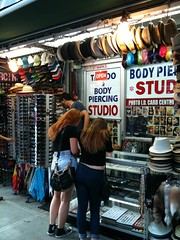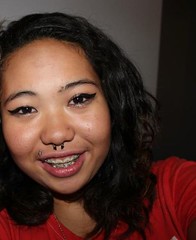Nadia, a 16-year-old student from Manhattan, walked up to the hole-in-the-wall shop at 1 St. Marks Place, asked for a navel piercing and was promptly ushered in. She sat in a shabby black chair. Her belly button was cleaned, a needle pushed through, and jewelry stuck in. It happened quickly, and cost $20.
For young teenagers, St. Marks Place has long been synonymous with cheap grub and drug paraphernalia – and piercings without parental supervision. But that tradition will end in October, when a state law passed by Gov. Andrew Cuomo will make it illegal for people under the age of 18 to get a piercing without the written consent of a parent.
“Body piercing can result in severe health risks and it is our obligation as New Yorkers and parents to make sure that our teens are taking every precaution to remain healthy and safe,” Gov. Cuomo said in a press release after the law was passed last month.
Nadia, who did not want her full name used for fear of repercussions from her employer, said piercings made sense at a younger age, and she wouldn’t have gotten hers if she was over 18. “I plan on taking them out [of] my navel as I get a little bit older because I think it wouldn’t be appropriate to have later on in life,” she said.
Her mother, Kim, 53, is of a different mindset. “I don’t think children should have piercings,” she said, questioning the cleanliness of the place her daughter visited. “I don’t think these places are sterilizing things. Too many people are going in and out.”
Jason Armstrong, 26, of Queens, has been working at 1 St. Marks Place for six years as a body piercer because it has a high volume of customers, allowing him to make what he said was a nice salary. He said he had learned to pierce at seminars around the country.
Like many others on St. Marks Place, Mr. Armstrong has performed body piercings without parental consent, though he insisted he had never pierced the genitals of minors. He uses an autoclave machine, which sterilizes instruments with high-pressure steam, but he acknowledged that about 1 in 20 kids he pierces might develop an infection from poor aftercare.
With unsterilized needles, the gamble is greater. Dr. Katie Malbon, 40, a pediatrician at Mount Sinai Adolescent Health Center, cited health risks including Hepatitis B, H.I.V., and potentially fatal blood infections. And George Blumenthal, 57, a dentist also affiliated with the Adolescent Health Center, said most teens don’t keep oral piercings clean, leading to bacteria and plaque. Tongue rings can also cause irrevocable damage to tooth enamel, he said.
Mr. Armstrong doubted the new regulations would keep studios from performing piercings on minors. “The whole strip, all over New York, the west side, the east side, Queens, the Bronx – no matter where you go, people [will] do it,” he said.
Dmitry Farber, a manager at Addiction NYC, said business at his shop at 27 St. Marks Place wouldn’t be affected, since it didn’t pierce minors to begin with. “I was under the impression that there was a law already,” he said. But he thought other shops were in a different position. “That’s probably the majority of their business, is piercing little kids,” he said.
Until the new law goes into effect Oct. 28, studios should have no shortage of underage customers. Manhattan resident Christina Auricchio, 15, got her navel and lip pierced on St. Marks Place even though she recognized the health risks associated with unsterilized needles. “I get worried thinking about what could happen if [the needles] weren’t clean,” she said. “But I still get them.”
Editor’s Note: The last name of a subject was removed from the original version of this post due to a disagreement about whether or not the subject consented to be interviewed for publication.





